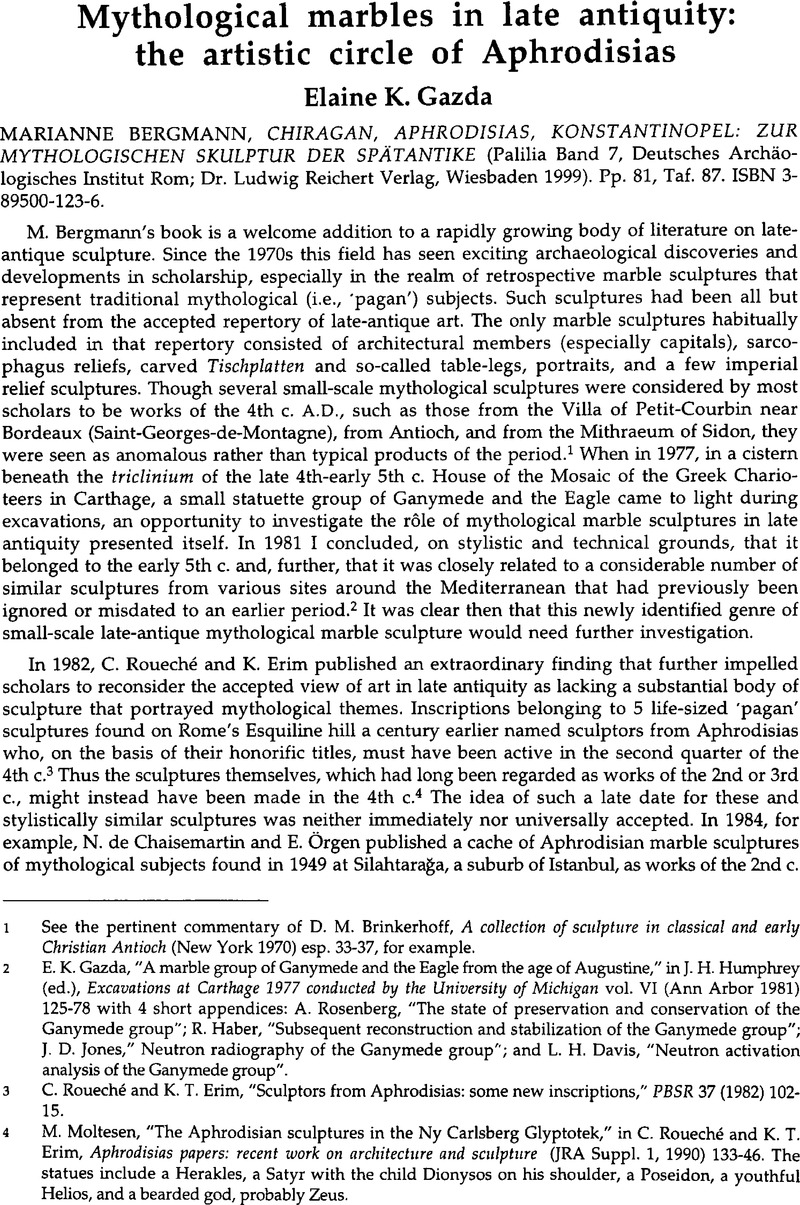No CrossRef data available.
Article contents
Mythological marbles in late antiquity: the artistic circle of Aphrodisias - Marianne Bergmann, CHIRAGAN, APHRODISIAS, KONSTANTINOPEL: ZUR MYTHOLOGISCHEN SKULPTUR DER SPÄTANTIKE (Palilia Band 7, Deutsches Archäologisches Institut Rom; Dr. Ludwig Reichert Verlag, Wiesbaden 1999). Pp. 81, Taf. 87. ISBN 3-89500-123-6.
Published online by Cambridge University Press: 16 February 2015
Abstract

- Type
- Reviews
- Information
- Copyright
- Copyright © Journal of Roman Archaeology L.L.C. 2002
References
1 See the pertinent commentary of Brinkerhoff, D. M., A collection of sculpture in classical and early Christian Antioch (New York 1970) esp. 33–37, for exampleGoogle Scholar.
2 Gazda, E. K., “A marble group of Ganymede and the Eagle from the age of Augustine,” in Humphrey, J. H. (ed.), Excavations at Carthage 1977 conducted by the University of Michigan vol. VI (Ann Arbor 1981) 125–78Google Scholar with 4 short appendices: A. Rosenberg, “The state of preservation and conservation of the Ganymede group”; R. Haber, “Subsequent reconstruction and stabilization of the Ganymede group”; J. D. Jones, “Neutron radiography of the Ganymede group”; and L. H. Davis, “Neutron activation analysis of the Ganymede group”.
3 Roueché, C. and Erim, K. T., “Sculptors from Aphrodisias: some new inscriptions,” PBSR 37 (1982) 102–15Google Scholar.
4 Moltesen, M., “The Aphrodisian sculptures in the Ny Carlsberg Glyptotek,” in Roueché, C. and Erim, K. T., Aphrodisias papers: recent work on architecture and sculpture (JRA Suppl. 1, 1990) 133–46Google Scholar. The statues include a Herakles, a Satyr with the child Dionysos on his shoulder, a Poseidon, a youthful Helios, and a bearded god, probably Zeus.
5 de Chaisemartin, N. and Örgen, E., Les documents sculptés de Silahtarağa (IFEA Mém. 46, 1984)Google Scholar with review by Fleischer, R. in Gnomon 1988, 61–65 Google Scholar.
6 Bonfante, L. and Carter, C., “An absent Herakles and a Hesperid: a late antique marble group in New York,” AJA 91 (1987) 247–57CrossRefGoogle Scholar; Dresken-Weiland, J., Relief Tischplatten aits theodosianischer Zeit (Vatican City 1991)Google Scholar; Hannestad, N., Tradition in late antique sculpture: conservation – modernization – production (Åarhus 1994)Google Scholar; Kiilerich, B., Late fourth century classicism in the plastic arts (Odense 1993)Google Scholar; Kiilerich, B. and Torp, H., “Mythological sculpture in the fourth century A.D.: the Esquiline group and the Silahtaraga statues,” IstMitt 44 (1994) 307–16Google Scholar; Stirling, L., Mythological statuary in late antiquity: a case study of villa decoration in Southwest Gaul (Ph.D. diss., Univ. of Michigan 1994)Google Scholar; and ead., “Divinities and heroes in the age of Ausonius: a late-antique villa and sculptural collection at Saint-Georges-de-Montagne (Gironde),” RA 1996, 103-43. Bergmann did not become aware of Stirling's work until she had completed most of her manuscript.
7 Smith, R. R. R., “Hellenistic sculpture under the Roman empire: fishermen and satyrs at Aphrodisias,” in Palagia, O. and Coulson, W. (edd.), Regional schools in Hellenistic sculpture (Oxford 1998) 253–60Google Scholar. See also the three volumes of Aphrodisias papers (JRA Suppls. 1, 2 and 20). I have not been able to consult a recent article by Moltesen, M., “The Esquiline Group: Aphrodisian statues in the Ny Carlsberg Glyptotek,” Antike Plastik 27 (2000 [2002]) 111–29Google Scholar, which argues for an Imperial rather than late-antique date for the Esquiline sculptures.
8 Of the more than 200 sculptures found at the site, most of the sculptures from the villa of Chiragan were discovered in 1826-30 (Bergmann 26).
9 Barry's discovery was not fully published at the time of Bergmann's writing.
10 In 1994, Stirling (supra n.6) came to a similar conclusion but allowed for the possibility that others capitals, such as Antioch or Thessalonike, might also have been redistribution centers (93).
11 See Squarciapino, M., La scuola di Afrodisia (Rome 1943) 97–98 Google Scholar and passim for still-valuable remarks on the long-standing debate concerning a school of Aphrodisias and on what constitutes a ‘school’.
12 Moreover, Neutron Activation Analysis of the marble used for the Ganymede pointed more to Ephesos than to any other site in Asia Minor.




